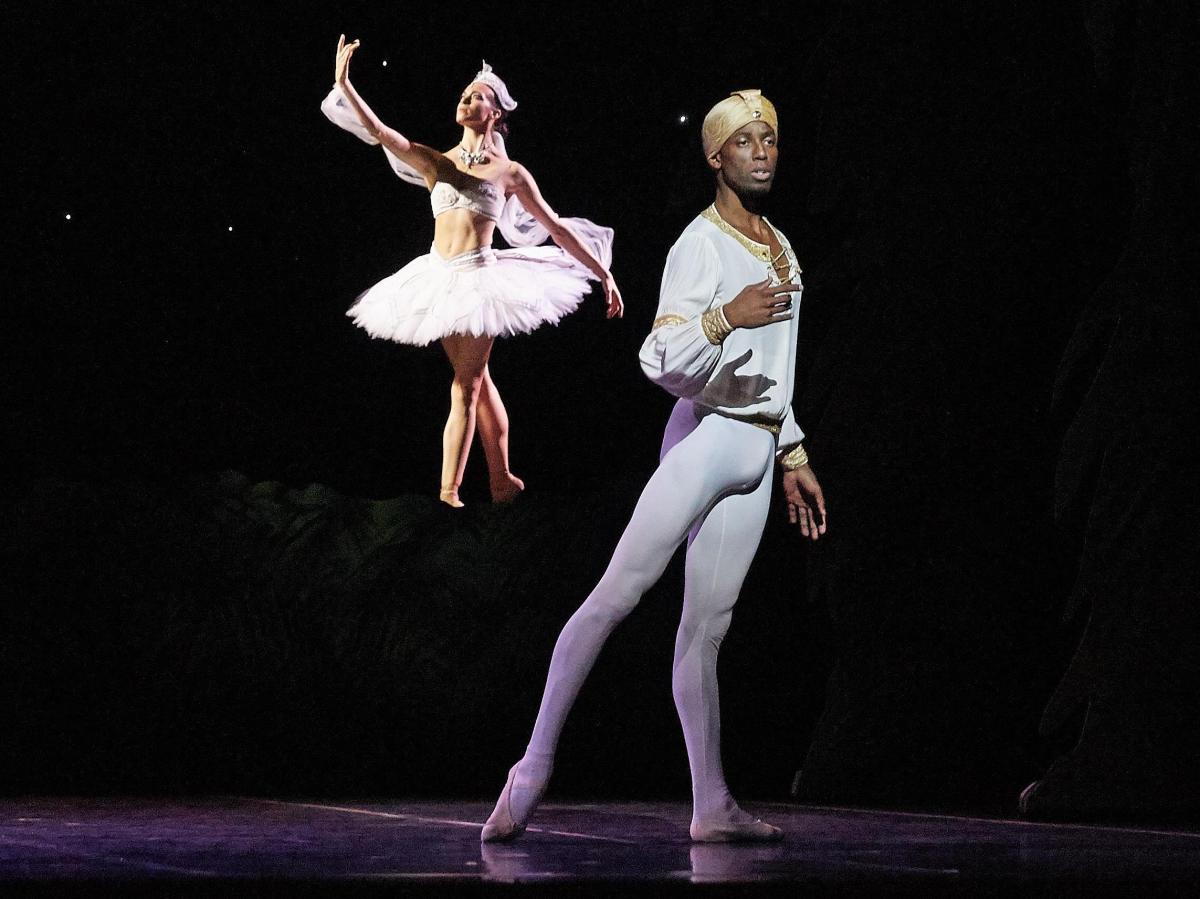Juan Carlos Osma as Solor and Alexa Tuzil as Nikiya in La Bayadère. Image: Sergey Pevnev.
The most painful thing for a reviewer is to see flaws in perfection, especially when you appreciate the work that has gone into a performance. The opening night of La Bayadère – ‘the temple dancer’ – performed at His Majesty’s Theatre in Perth was perfection.
‘Dancers don’t take up the profession without full understanding of the hard work they will endure,’ artistic Director Aurêlien Scannella said in his after show summation, and on this evening, it was an understatement. Dayana Hardy Acuña was exquisitely fragile and elegant as the temple dancer, Nikiya, and Chihiro Nomura spirited and cheeky as the demanding Edith willing to commit murder to possess her prince, Solor (Matthew Lehmann), resplendent in Indian dress. Their pas de deux were faultless. The contrast felt marked between Lehmann and the tiny female leads he could so easily lift with one hand. All three handled the acting of their roles well with a heart-stopping ending before a magnificent backdrop designed by Gary Harris.
It was the corps de ballet, however, which brought gasps from the audience, most of whom may never have seen La Bayadère before. Originally choreographed in 1877, the dancing demanded in this ballet by nineteen (I counted them, popping out from the wings one at a time!) female, tutu-clad ballerinas as they descended a flight of stairs from their Kingdom in the mountains, was synchronicity at its best to music by Ludwig Minkus arranged by Nigel Gaynor. As ‘Shades’ (bayadères who died for love) they provided a setting for Solor, hallucinating through time spent grieving in an Opium den, to meet Nikiya again after her death. For ‘shock’ value it could not have been better but, timewise, the dancing in the second Act became repetitious and too extended, though the three soloists were a credit to the company.
By comparison, the time allotted to the first Act, highlighting the Temple dancers and establishing the story line, seemed brief, rushed and not well-defined. The male dancers – bare-chested and turbaned – did, at least, have an opportunity to shine and Julio Blanes made a spectacular entry as the Golden Idol but the continuity of the story line was difficult to grasp.
La Bayadère has been ‘modernised’ by Queensland ballet’s choreographer, Greg Horsman, but it is essentially the coming together of British and Indian culture through marriage and the costumes of wedding guests, groom and groomsmen in Act 3 did portray that. At this point, however, there seemed to be a blurring of the lines between modern and classical representation when the bride and bridesmaids appeared in yet more tutus. This caused confusion first of all because of the similarity with the tutus worn by the 19 ‘shades’ and secondly because when Edith first met her future in-laws, she wore a beautiful red sari.
At times, it seemed that storytelling was sacrificed to favour dancing expertise in traditional dress which could well have been done in the beautiful clothing of the time. There can be no doubt that the most notable ballets of the 19th century are
breathtaking in classical costuming and movement but many in the 21st century have embraced varying degrees of change, particularly in The Nutcracker. That said, this production with its lavish sets and skilful dancing was a great demonstration of what collaboration between three major ballet companies can achieve.
4 stars out of 5 ★★★★
La Bayadère
a co-production between West Australian Ballet, Queensland Ballet and Royal Winnipeg Ballet
Choreographer: Greg Horsman after Marius Petipa
Assistant Repetiteur: Clytie Campbell
Set & Costume Design: Gary Harris
Lighting: Jon Buswell
Music: Ludwig Minkus
Music Arrangement: Nigel Gaynor
Conductor: Judith Yan
9-25 May 2019
His Majesty’s Theatre
Tickets $22-$120





